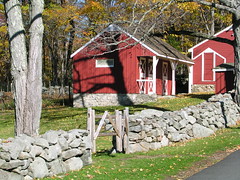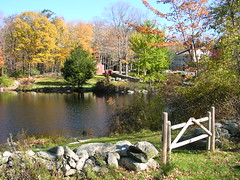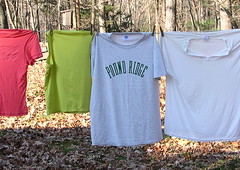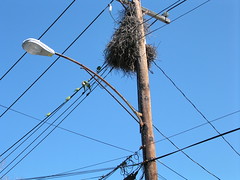Monk Parakeets = Bad PR for UI; Ferries on the Sound; Broadwater and the Public Use of Public Waters
Lots of people agree that the birds can be a nuisance but they also think there should be a better way of getting rid of them. UI workers are taking down the nests, capturing the birds and handing them over to the U.S. Department of Agriculture, which kills them using carbon monoxide (the New Haven Register keeps saying carbon dioxide, but that doesn't make sense to me). Is that the only choice?
I posted a couple of items about it in the last week or so (here and http://thissphere.blogspot.com/2005/11/priorities.html
), and one in July, and a number of people have found their way here to read them after searching online for monk parakeets. One of those readers left a comment last week, anonymously, on my July post:
The USDA’s agents who kill birds and animals at taxpayer’s expense for private industry, plan to use Connecticut’s program as a test case. If successful, the agency may start using similar draconian measures in other states.
... One method that has been used successfully in New York and New Jersey is to wait until spring and remove nests from utility poles before breeding season.
Representative Richard Roy, who lives in Milford (where some of the birds nest) and is chairman of the house's Environment Committee, called UI officials and other to Hartford yesterday to talk more about that alternative. The New Haven Register reported:
Roy said he is also urging UI to use a method tried in several other states of "continuous maintenance" to discourage monk parakeets from building nests on utility poles. That policy requires utility workers to remove a nest and then keep returning to knock down the nests the parakeets rebuild.
Roy said that, after having their nests knocked down several times, the birds usually seek a different location.
UI might be starting to tire of the bad publicity. The company said that the parakeets are responsible for one power outage a month, on average, and have caused four fires since 2002. But, the company's spokesman said, UI
... intends to "continue to work with the responsible agencies to find a solution ... that is more humane."
Ferries ... You ever wonder what taking a ferry to work would be like? Plenty of people on Staten Island do it, of course, and it's a pleasant ride -- 25 minutes or so across the Upper Bay, which is beautiful and well protected. On the other hand, I once visited a guy who lived on one of the islands on Maryland's Eastern Shore -- Deal maybe, or Smith, I forget -- and when I suggested that it must be neat to take the ferry, which was small and loud, all the time, he said it was like taking a 20-minute elevator ride twice a day.
What about more ferries on Long Island Sound? The roads and the trains are crowded, so ferry service from to Manhattan sounds like a good idea, except for two things -- it's no bargain and it's slow.
Some planning agencies did a study that recommends thinking about running high speed ferries to the city from Bridgeport, Stamford, Rye, New Rochelle, and Glen Cove. Here's what the Stamford Advocate says:
Under the "base model" for service -- $15 a trip traveling at 35 knots -- attracting riders for a Bridgeport to Stamford to midtown Manhattan ferry would be difficult because it would be the same price as Metro-North Railroad's New Haven Line, only slower, according to the study.
Slower is one thing. What about comfort? Sailors tell me that the Sound is notoriously rough in winter -- it's small enough so that the waves and swells slosh back and forth, like in a bathtub, making it choppy and unpleasant. The Advocate story doesn't say if the cost-benefit analysis includes the price of regular supplies of Dramamine.
Security checks for boaters? ... There was an interesting nugget in an otherwise unremarkable Hartford Courant story about last night's meeting ot the Connecticut LNG task force. One of the troubling issues is that the huge LNG facility that TransCanada and Shell want to put in the middle of the Sound is that it would require the Coast Guard to enforce a off-limits area around the terminal, for security reasons. Some people (including me) think that it is unacceptable to close of publicly-owned waters for a big floating LNG factory.
Amy Kelley, Broadwater's spokeswoman, said last night that the no-boat zone might be up for review. According to the Courant she said:
the Coast Guard is considering whether boaters who had been checked out might have access to the as-yet unspecified security zones around the plant and the tankers.
At first reading, that sounds like it might be good news. But really, what would this checking out of boaters entail? What kind of personal information would the Coast Guard want to make sure you're a fisherman and not a terrorist? And why should anyone submit to that kind of intrusion when have the right to be on the Sound in the first place?








